Youngcare: Understanding Donor Behavior to Improve Marketing
VerifiedAdded on 2020/12/10
|9
|2978
|61
Report
AI Summary
This report examines donor behavior in the context of Youngcare, an Australian non-profit organization supporting young people with high care needs. The report investigates the challenges Youngcare faces in securing donations, particularly from Gen Y, and analyzes the influence of the consumer decision model (Engel, Blackwell, and Kollat) on donor behavior. It explores the importance of understanding donor motivations, external factors, and marketing strategies. The report also provides recommendations for Youngcare, including strategies to engage Gen Y through social media, crowdfunding, and transparency, as well as the application of the 4 P's of marketing mix. The analysis emphasizes the need for effective marketing to increase donations and support Youngcare's mission of providing appropriate housing and care options for young Australians with disabilities.
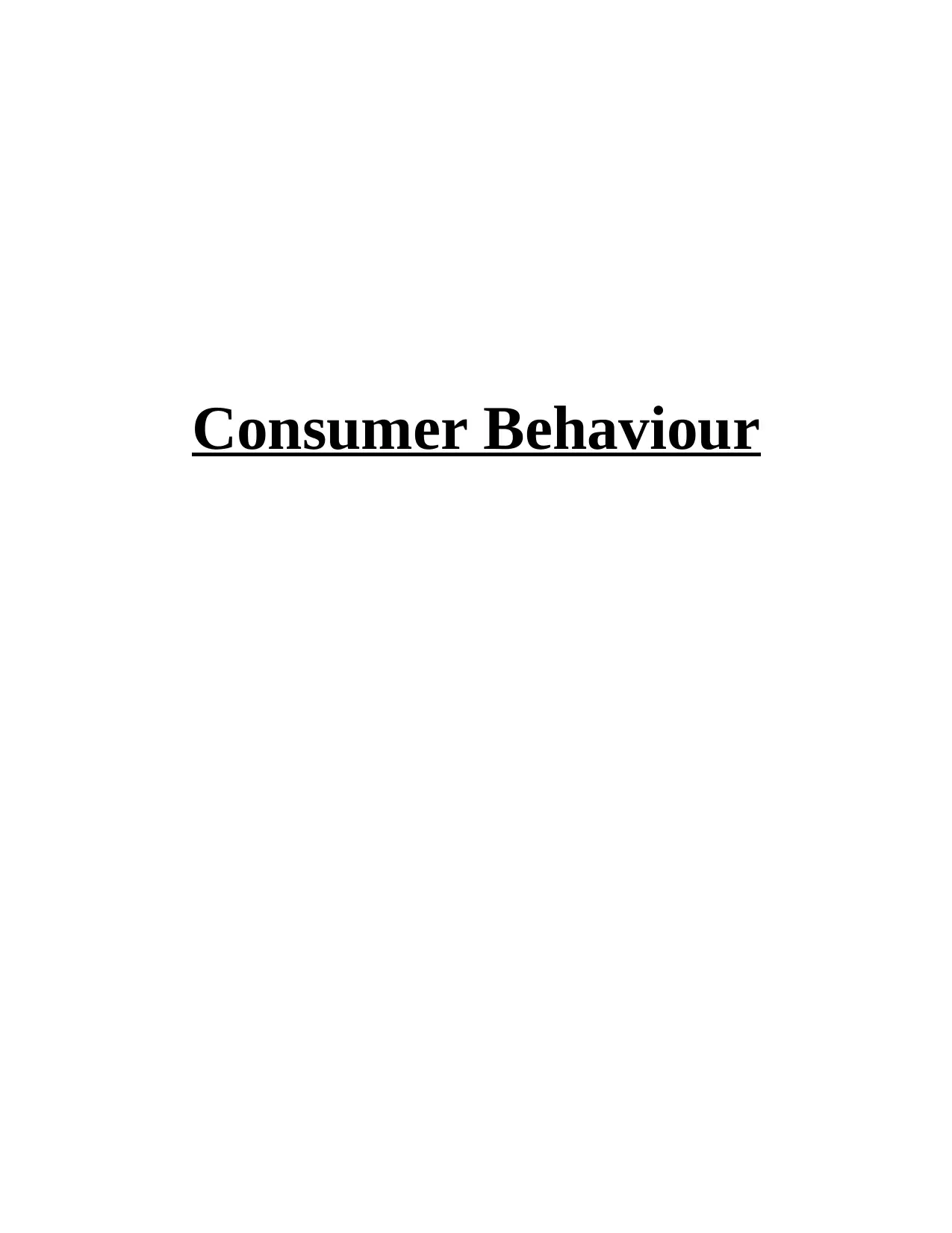
Consumer Behaviour
Paraphrase This Document
Need a fresh take? Get an instant paraphrase of this document with our AI Paraphraser
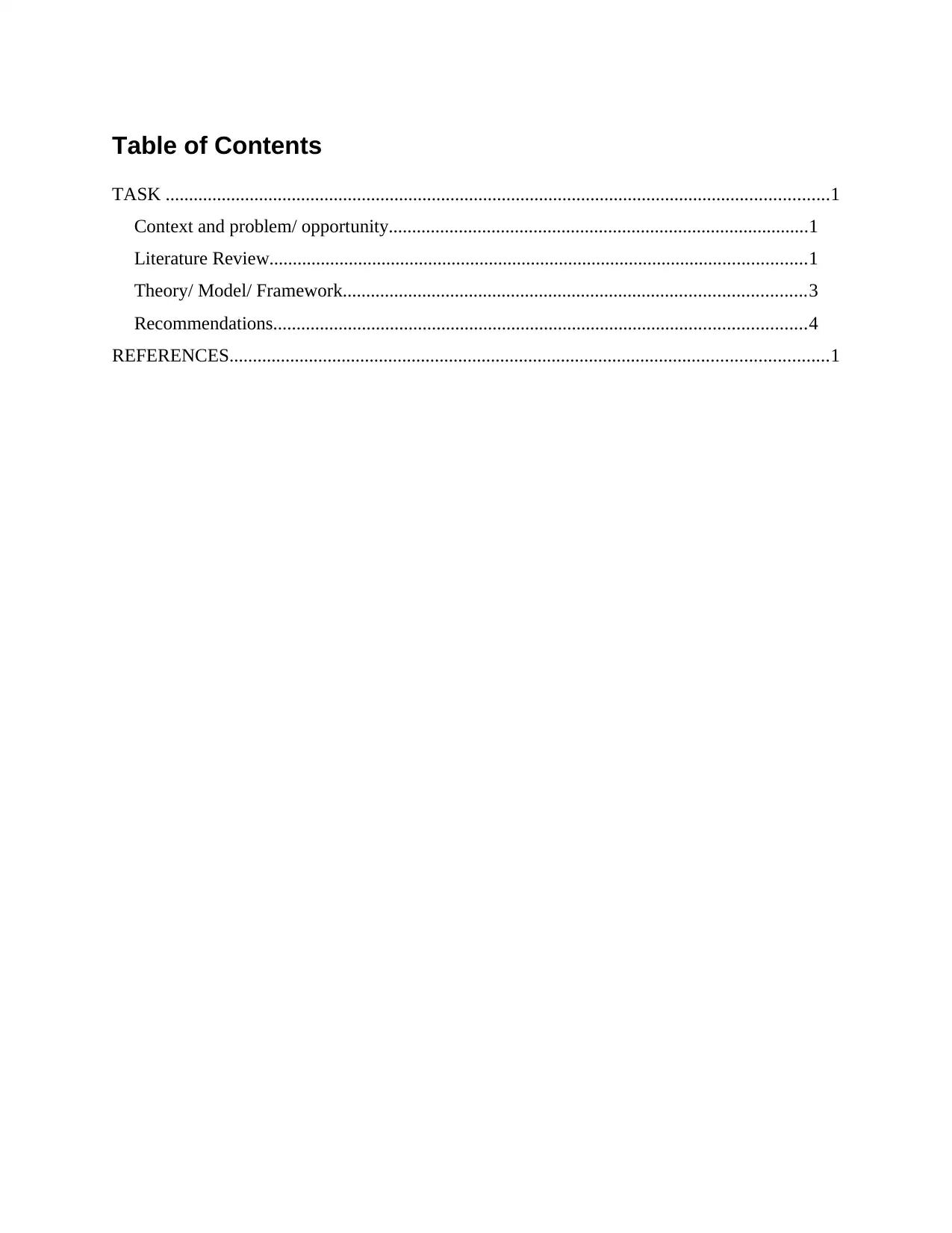
Table of Contents
TASK ..............................................................................................................................................1
Context and problem/ opportunity..........................................................................................1
Literature Review...................................................................................................................1
Theory/ Model/ Framework...................................................................................................3
Recommendations..................................................................................................................4
REFERENCES................................................................................................................................1
TASK ..............................................................................................................................................1
Context and problem/ opportunity..........................................................................................1
Literature Review...................................................................................................................1
Theory/ Model/ Framework...................................................................................................3
Recommendations..................................................................................................................4
REFERENCES................................................................................................................................1
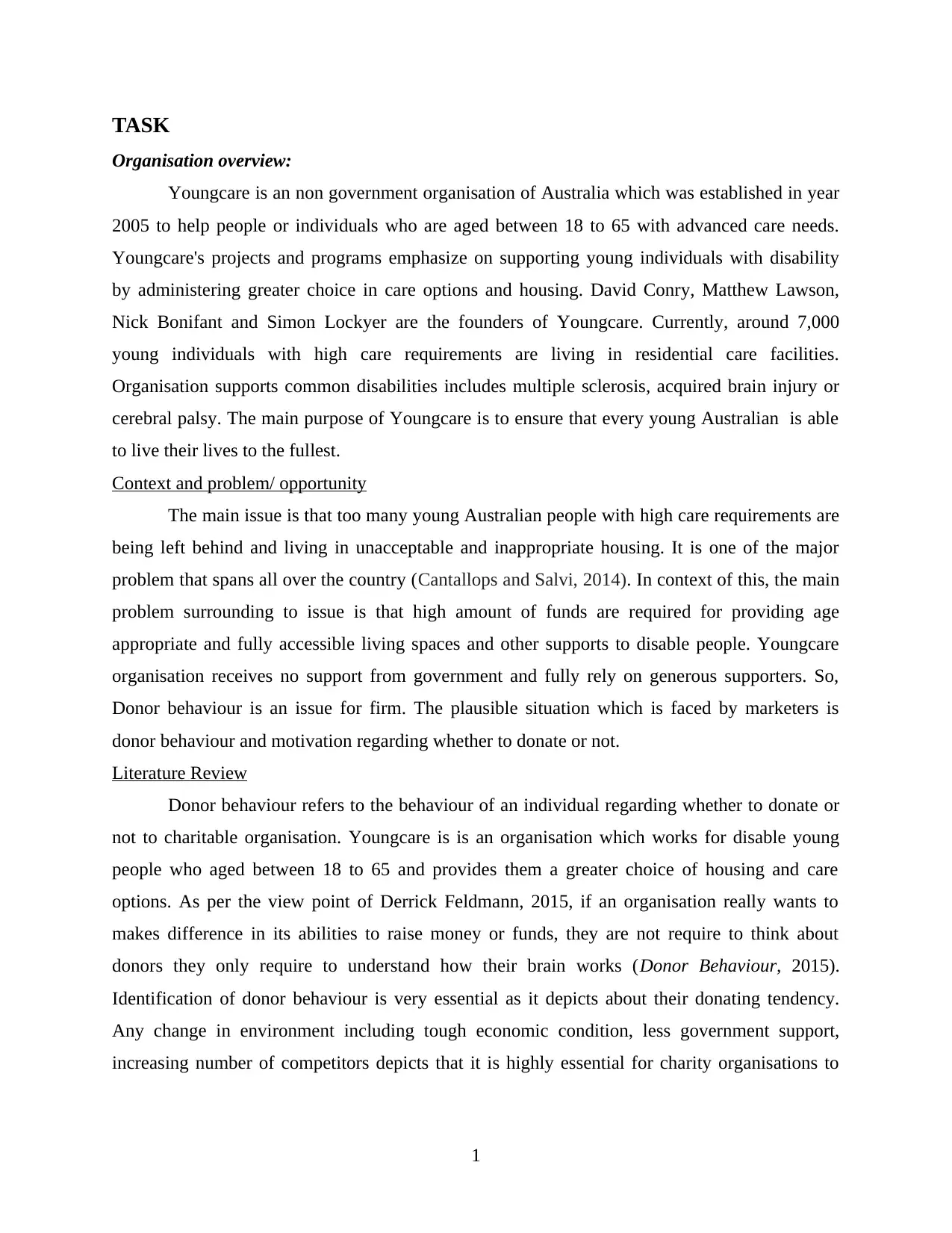
TASK
Organisation overview:
Youngcare is an non government organisation of Australia which was established in year
2005 to help people or individuals who are aged between 18 to 65 with advanced care needs.
Youngcare's projects and programs emphasize on supporting young individuals with disability
by administering greater choice in care options and housing. David Conry, Matthew Lawson,
Nick Bonifant and Simon Lockyer are the founders of Youngcare. Currently, around 7,000
young individuals with high care requirements are living in residential care facilities.
Organisation supports common disabilities includes multiple sclerosis, acquired brain injury or
cerebral palsy. The main purpose of Youngcare is to ensure that every young Australian is able
to live their lives to the fullest.
Context and problem/ opportunity
The main issue is that too many young Australian people with high care requirements are
being left behind and living in unacceptable and inappropriate housing. It is one of the major
problem that spans all over the country (Cantallops and Salvi, 2014). In context of this, the main
problem surrounding to issue is that high amount of funds are required for providing age
appropriate and fully accessible living spaces and other supports to disable people. Youngcare
organisation receives no support from government and fully rely on generous supporters. So,
Donor behaviour is an issue for firm. The plausible situation which is faced by marketers is
donor behaviour and motivation regarding whether to donate or not.
Literature Review
Donor behaviour refers to the behaviour of an individual regarding whether to donate or
not to charitable organisation. Youngcare is is an organisation which works for disable young
people who aged between 18 to 65 and provides them a greater choice of housing and care
options. As per the view point of Derrick Feldmann, 2015, if an organisation really wants to
makes difference in its abilities to raise money or funds, they are not require to think about
donors they only require to understand how their brain works (Donor Behaviour, 2015).
Identification of donor behaviour is very essential as it depicts about their donating tendency.
Any change in environment including tough economic condition, less government support,
increasing number of competitors depicts that it is highly essential for charity organisations to
1
Organisation overview:
Youngcare is an non government organisation of Australia which was established in year
2005 to help people or individuals who are aged between 18 to 65 with advanced care needs.
Youngcare's projects and programs emphasize on supporting young individuals with disability
by administering greater choice in care options and housing. David Conry, Matthew Lawson,
Nick Bonifant and Simon Lockyer are the founders of Youngcare. Currently, around 7,000
young individuals with high care requirements are living in residential care facilities.
Organisation supports common disabilities includes multiple sclerosis, acquired brain injury or
cerebral palsy. The main purpose of Youngcare is to ensure that every young Australian is able
to live their lives to the fullest.
Context and problem/ opportunity
The main issue is that too many young Australian people with high care requirements are
being left behind and living in unacceptable and inappropriate housing. It is one of the major
problem that spans all over the country (Cantallops and Salvi, 2014). In context of this, the main
problem surrounding to issue is that high amount of funds are required for providing age
appropriate and fully accessible living spaces and other supports to disable people. Youngcare
organisation receives no support from government and fully rely on generous supporters. So,
Donor behaviour is an issue for firm. The plausible situation which is faced by marketers is
donor behaviour and motivation regarding whether to donate or not.
Literature Review
Donor behaviour refers to the behaviour of an individual regarding whether to donate or
not to charitable organisation. Youngcare is is an organisation which works for disable young
people who aged between 18 to 65 and provides them a greater choice of housing and care
options. As per the view point of Derrick Feldmann, 2015, if an organisation really wants to
makes difference in its abilities to raise money or funds, they are not require to think about
donors they only require to understand how their brain works (Donor Behaviour, 2015).
Identification of donor behaviour is very essential as it depicts about their donating tendency.
Any change in environment including tough economic condition, less government support,
increasing number of competitors depicts that it is highly essential for charity organisations to
1
⊘ This is a preview!⊘
Do you want full access?
Subscribe today to unlock all pages.

Trusted by 1+ million students worldwide
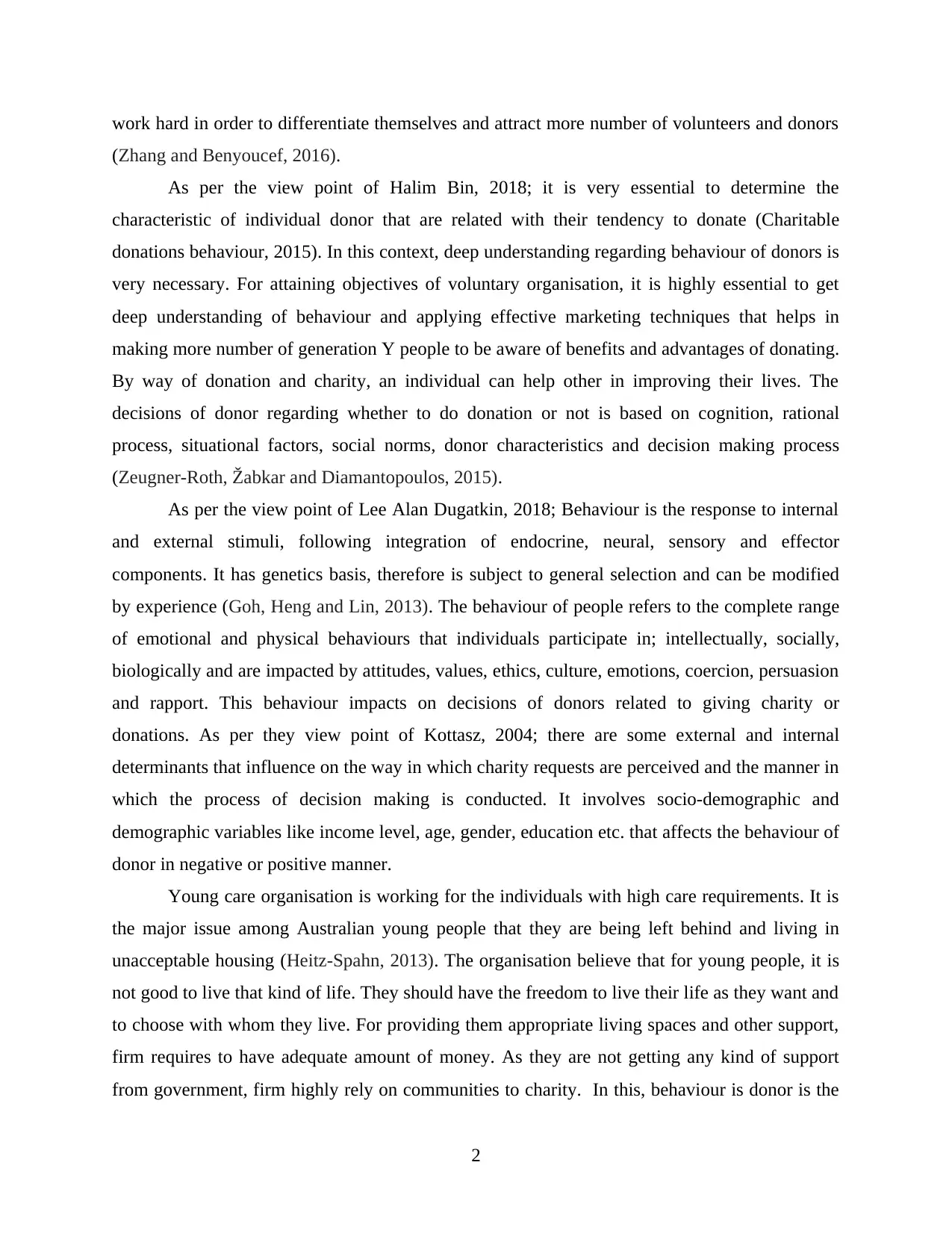
work hard in order to differentiate themselves and attract more number of volunteers and donors
(Zhang and Benyoucef, 2016).
As per the view point of Halim Bin, 2018; it is very essential to determine the
characteristic of individual donor that are related with their tendency to donate (Charitable
donations behaviour, 2015). In this context, deep understanding regarding behaviour of donors is
very necessary. For attaining objectives of voluntary organisation, it is highly essential to get
deep understanding of behaviour and applying effective marketing techniques that helps in
making more number of generation Y people to be aware of benefits and advantages of donating.
By way of donation and charity, an individual can help other in improving their lives. The
decisions of donor regarding whether to do donation or not is based on cognition, rational
process, situational factors, social norms, donor characteristics and decision making process
(Zeugner-Roth, Žabkar and Diamantopoulos, 2015).
As per the view point of Lee Alan Dugatkin, 2018; Behaviour is the response to internal
and external stimuli, following integration of endocrine, neural, sensory and effector
components. It has genetics basis, therefore is subject to general selection and can be modified
by experience (Goh, Heng and Lin, 2013). The behaviour of people refers to the complete range
of emotional and physical behaviours that individuals participate in; intellectually, socially,
biologically and are impacted by attitudes, values, ethics, culture, emotions, coercion, persuasion
and rapport. This behaviour impacts on decisions of donors related to giving charity or
donations. As per they view point of Kottasz, 2004; there are some external and internal
determinants that influence on the way in which charity requests are perceived and the manner in
which the process of decision making is conducted. It involves socio-demographic and
demographic variables like income level, age, gender, education etc. that affects the behaviour of
donor in negative or positive manner.
Young care organisation is working for the individuals with high care requirements. It is
the major issue among Australian young people that they are being left behind and living in
unacceptable housing (Heitz-Spahn, 2013). The organisation believe that for young people, it is
not good to live that kind of life. They should have the freedom to live their life as they want and
to choose with whom they live. For providing them appropriate living spaces and other support,
firm requires to have adequate amount of money. As they are not getting any kind of support
from government, firm highly rely on communities to charity. In this, behaviour is donor is the
2
(Zhang and Benyoucef, 2016).
As per the view point of Halim Bin, 2018; it is very essential to determine the
characteristic of individual donor that are related with their tendency to donate (Charitable
donations behaviour, 2015). In this context, deep understanding regarding behaviour of donors is
very necessary. For attaining objectives of voluntary organisation, it is highly essential to get
deep understanding of behaviour and applying effective marketing techniques that helps in
making more number of generation Y people to be aware of benefits and advantages of donating.
By way of donation and charity, an individual can help other in improving their lives. The
decisions of donor regarding whether to do donation or not is based on cognition, rational
process, situational factors, social norms, donor characteristics and decision making process
(Zeugner-Roth, Žabkar and Diamantopoulos, 2015).
As per the view point of Lee Alan Dugatkin, 2018; Behaviour is the response to internal
and external stimuli, following integration of endocrine, neural, sensory and effector
components. It has genetics basis, therefore is subject to general selection and can be modified
by experience (Goh, Heng and Lin, 2013). The behaviour of people refers to the complete range
of emotional and physical behaviours that individuals participate in; intellectually, socially,
biologically and are impacted by attitudes, values, ethics, culture, emotions, coercion, persuasion
and rapport. This behaviour impacts on decisions of donors related to giving charity or
donations. As per they view point of Kottasz, 2004; there are some external and internal
determinants that influence on the way in which charity requests are perceived and the manner in
which the process of decision making is conducted. It involves socio-demographic and
demographic variables like income level, age, gender, education etc. that affects the behaviour of
donor in negative or positive manner.
Young care organisation is working for the individuals with high care requirements. It is
the major issue among Australian young people that they are being left behind and living in
unacceptable housing (Heitz-Spahn, 2013). The organisation believe that for young people, it is
not good to live that kind of life. They should have the freedom to live their life as they want and
to choose with whom they live. For providing them appropriate living spaces and other support,
firm requires to have adequate amount of money. As they are not getting any kind of support
from government, firm highly rely on communities to charity. In this, behaviour is donor is the
2
Paraphrase This Document
Need a fresh take? Get an instant paraphrase of this document with our AI Paraphraser
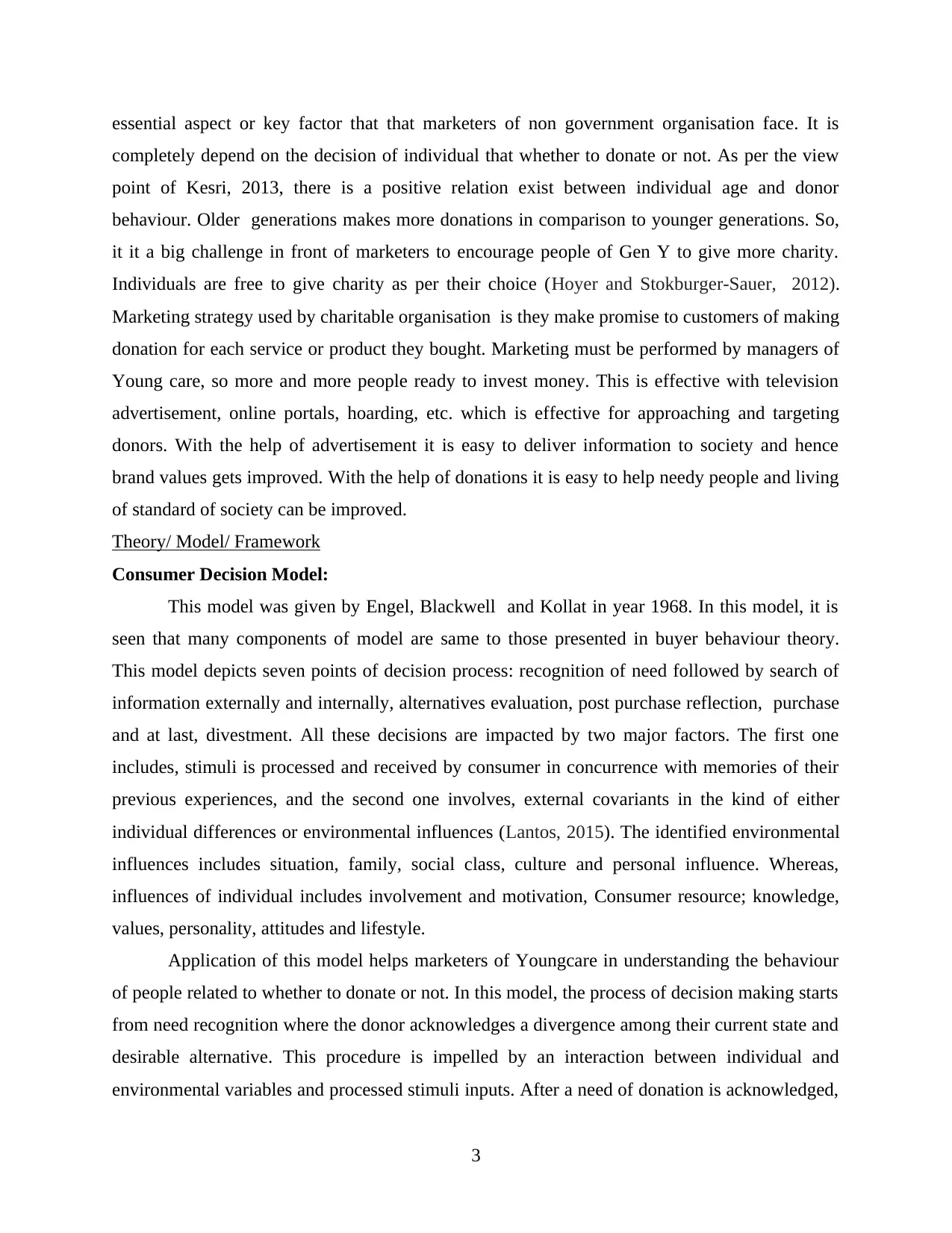
essential aspect or key factor that that marketers of non government organisation face. It is
completely depend on the decision of individual that whether to donate or not. As per the view
point of Kesri, 2013, there is a positive relation exist between individual age and donor
behaviour. Older generations makes more donations in comparison to younger generations. So,
it it a big challenge in front of marketers to encourage people of Gen Y to give more charity.
Individuals are free to give charity as per their choice (Hoyer and Stokburger-Sauer, 2012).
Marketing strategy used by charitable organisation is they make promise to customers of making
donation for each service or product they bought. Marketing must be performed by managers of
Young care, so more and more people ready to invest money. This is effective with television
advertisement, online portals, hoarding, etc. which is effective for approaching and targeting
donors. With the help of advertisement it is easy to deliver information to society and hence
brand values gets improved. With the help of donations it is easy to help needy people and living
of standard of society can be improved.
Theory/ Model/ Framework
Consumer Decision Model:
This model was given by Engel, Blackwell and Kollat in year 1968. In this model, it is
seen that many components of model are same to those presented in buyer behaviour theory.
This model depicts seven points of decision process: recognition of need followed by search of
information externally and internally, alternatives evaluation, post purchase reflection, purchase
and at last, divestment. All these decisions are impacted by two major factors. The first one
includes, stimuli is processed and received by consumer in concurrence with memories of their
previous experiences, and the second one involves, external covariants in the kind of either
individual differences or environmental influences (Lantos, 2015). The identified environmental
influences includes situation, family, social class, culture and personal influence. Whereas,
influences of individual includes involvement and motivation, Consumer resource; knowledge,
values, personality, attitudes and lifestyle.
Application of this model helps marketers of Youngcare in understanding the behaviour
of people related to whether to donate or not. In this model, the process of decision making starts
from need recognition where the donor acknowledges a divergence among their current state and
desirable alternative. This procedure is impelled by an interaction between individual and
environmental variables and processed stimuli inputs. After a need of donation is acknowledged,
3
completely depend on the decision of individual that whether to donate or not. As per the view
point of Kesri, 2013, there is a positive relation exist between individual age and donor
behaviour. Older generations makes more donations in comparison to younger generations. So,
it it a big challenge in front of marketers to encourage people of Gen Y to give more charity.
Individuals are free to give charity as per their choice (Hoyer and Stokburger-Sauer, 2012).
Marketing strategy used by charitable organisation is they make promise to customers of making
donation for each service or product they bought. Marketing must be performed by managers of
Young care, so more and more people ready to invest money. This is effective with television
advertisement, online portals, hoarding, etc. which is effective for approaching and targeting
donors. With the help of advertisement it is easy to deliver information to society and hence
brand values gets improved. With the help of donations it is easy to help needy people and living
of standard of society can be improved.
Theory/ Model/ Framework
Consumer Decision Model:
This model was given by Engel, Blackwell and Kollat in year 1968. In this model, it is
seen that many components of model are same to those presented in buyer behaviour theory.
This model depicts seven points of decision process: recognition of need followed by search of
information externally and internally, alternatives evaluation, post purchase reflection, purchase
and at last, divestment. All these decisions are impacted by two major factors. The first one
includes, stimuli is processed and received by consumer in concurrence with memories of their
previous experiences, and the second one involves, external covariants in the kind of either
individual differences or environmental influences (Lantos, 2015). The identified environmental
influences includes situation, family, social class, culture and personal influence. Whereas,
influences of individual includes involvement and motivation, Consumer resource; knowledge,
values, personality, attitudes and lifestyle.
Application of this model helps marketers of Youngcare in understanding the behaviour
of people related to whether to donate or not. In this model, the process of decision making starts
from need recognition where the donor acknowledges a divergence among their current state and
desirable alternative. This procedure is impelled by an interaction between individual and
environmental variables and processed stimuli inputs. After a need of donation is acknowledged,
3
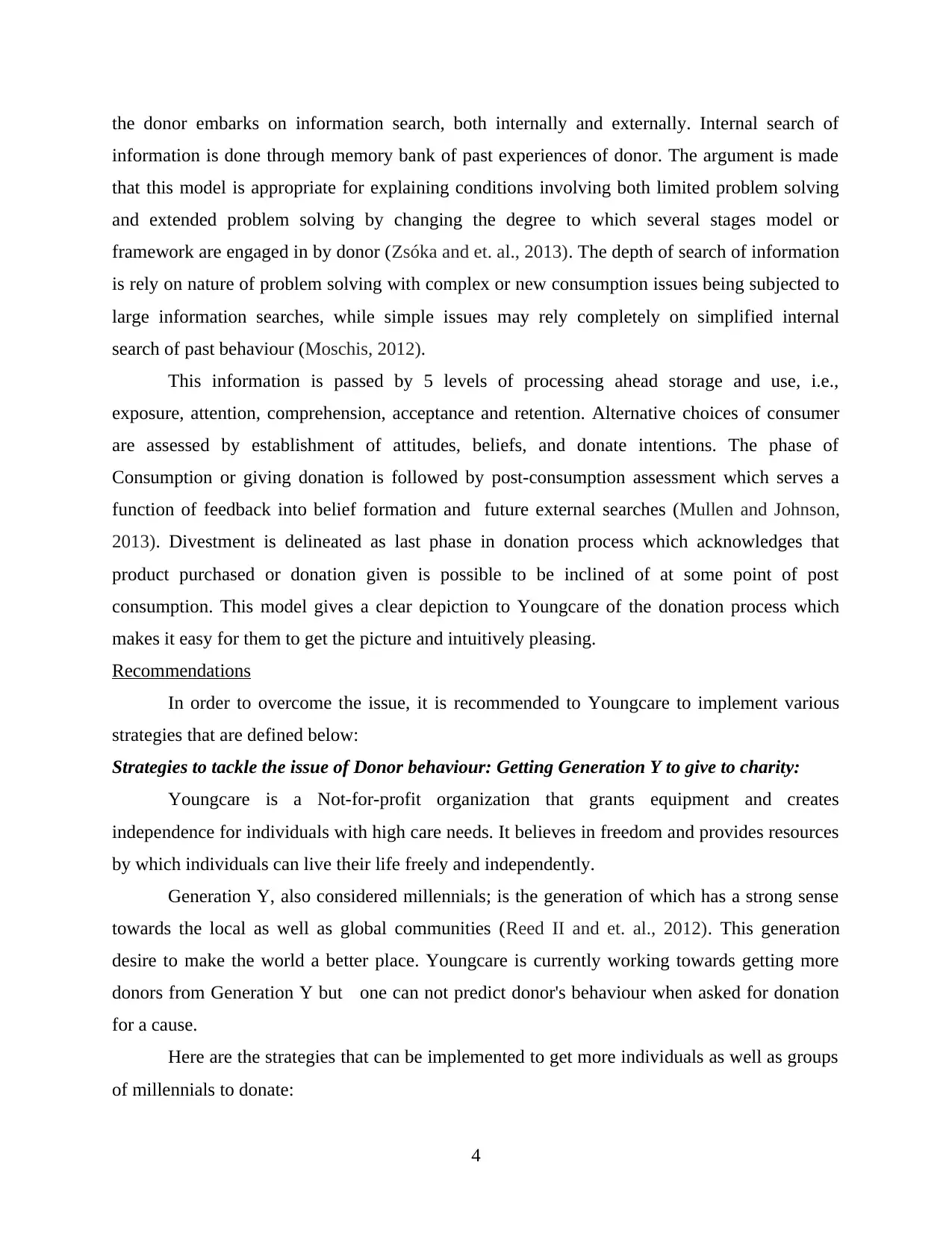
the donor embarks on information search, both internally and externally. Internal search of
information is done through memory bank of past experiences of donor. The argument is made
that this model is appropriate for explaining conditions involving both limited problem solving
and extended problem solving by changing the degree to which several stages model or
framework are engaged in by donor (Zsóka and et. al., 2013). The depth of search of information
is rely on nature of problem solving with complex or new consumption issues being subjected to
large information searches, while simple issues may rely completely on simplified internal
search of past behaviour (Moschis, 2012).
This information is passed by 5 levels of processing ahead storage and use, i.e.,
exposure, attention, comprehension, acceptance and retention. Alternative choices of consumer
are assessed by establishment of attitudes, beliefs, and donate intentions. The phase of
Consumption or giving donation is followed by post-consumption assessment which serves a
function of feedback into belief formation and future external searches (Mullen and Johnson,
2013). Divestment is delineated as last phase in donation process which acknowledges that
product purchased or donation given is possible to be inclined of at some point of post
consumption. This model gives a clear depiction to Youngcare of the donation process which
makes it easy for them to get the picture and intuitively pleasing.
Recommendations
In order to overcome the issue, it is recommended to Youngcare to implement various
strategies that are defined below:
Strategies to tackle the issue of Donor behaviour: Getting Generation Y to give to charity:
Youngcare is a Not-for-profit organization that grants equipment and creates
independence for individuals with high care needs. It believes in freedom and provides resources
by which individuals can live their life freely and independently.
Generation Y, also considered millennials; is the generation of which has a strong sense
towards the local as well as global communities (Reed II and et. al., 2012). This generation
desire to make the world a better place. Youngcare is currently working towards getting more
donors from Generation Y but one can not predict donor's behaviour when asked for donation
for a cause.
Here are the strategies that can be implemented to get more individuals as well as groups
of millennials to donate:
4
information is done through memory bank of past experiences of donor. The argument is made
that this model is appropriate for explaining conditions involving both limited problem solving
and extended problem solving by changing the degree to which several stages model or
framework are engaged in by donor (Zsóka and et. al., 2013). The depth of search of information
is rely on nature of problem solving with complex or new consumption issues being subjected to
large information searches, while simple issues may rely completely on simplified internal
search of past behaviour (Moschis, 2012).
This information is passed by 5 levels of processing ahead storage and use, i.e.,
exposure, attention, comprehension, acceptance and retention. Alternative choices of consumer
are assessed by establishment of attitudes, beliefs, and donate intentions. The phase of
Consumption or giving donation is followed by post-consumption assessment which serves a
function of feedback into belief formation and future external searches (Mullen and Johnson,
2013). Divestment is delineated as last phase in donation process which acknowledges that
product purchased or donation given is possible to be inclined of at some point of post
consumption. This model gives a clear depiction to Youngcare of the donation process which
makes it easy for them to get the picture and intuitively pleasing.
Recommendations
In order to overcome the issue, it is recommended to Youngcare to implement various
strategies that are defined below:
Strategies to tackle the issue of Donor behaviour: Getting Generation Y to give to charity:
Youngcare is a Not-for-profit organization that grants equipment and creates
independence for individuals with high care needs. It believes in freedom and provides resources
by which individuals can live their life freely and independently.
Generation Y, also considered millennials; is the generation of which has a strong sense
towards the local as well as global communities (Reed II and et. al., 2012). This generation
desire to make the world a better place. Youngcare is currently working towards getting more
donors from Generation Y but one can not predict donor's behaviour when asked for donation
for a cause.
Here are the strategies that can be implemented to get more individuals as well as groups
of millennials to donate:
4
⊘ This is a preview!⊘
Do you want full access?
Subscribe today to unlock all pages.

Trusted by 1+ million students worldwide
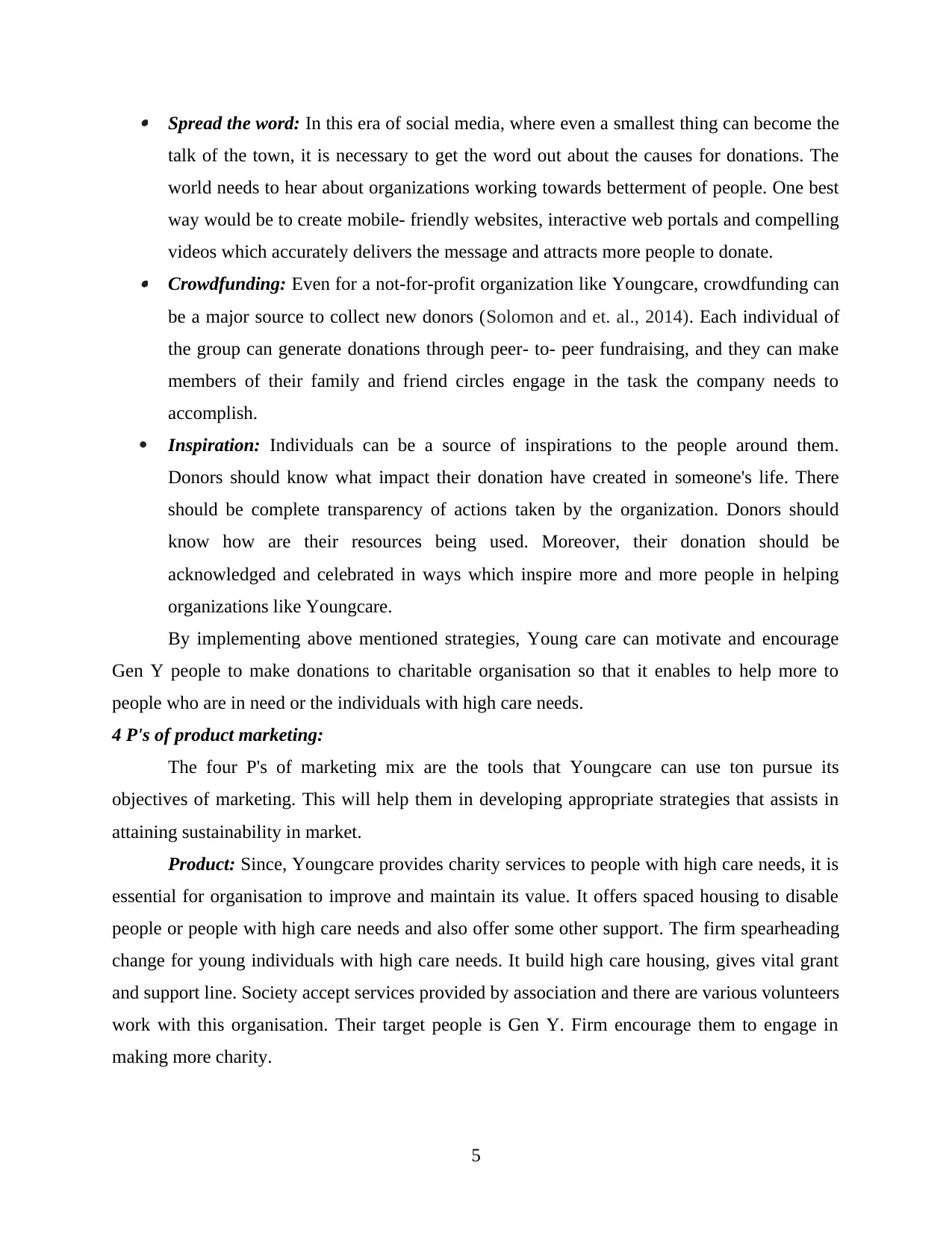
Spread the word: In this era of social media, where even a smallest thing can become the
talk of the town, it is necessary to get the word out about the causes for donations. The
world needs to hear about organizations working towards betterment of people. One best
way would be to create mobile- friendly websites, interactive web portals and compelling
videos which accurately delivers the message and attracts more people to donate. Crowdfunding: Even for a not-for-profit organization like Youngcare, crowdfunding can
be a major source to collect new donors (Solomon and et. al., 2014). Each individual of
the group can generate donations through peer- to- peer fundraising, and they can make
members of their family and friend circles engage in the task the company needs to
accomplish.
Inspiration: Individuals can be a source of inspirations to the people around them.
Donors should know what impact their donation have created in someone's life. There
should be complete transparency of actions taken by the organization. Donors should
know how are their resources being used. Moreover, their donation should be
acknowledged and celebrated in ways which inspire more and more people in helping
organizations like Youngcare.
By implementing above mentioned strategies, Young care can motivate and encourage
Gen Y people to make donations to charitable organisation so that it enables to help more to
people who are in need or the individuals with high care needs.
4 P's of product marketing:
The four P's of marketing mix are the tools that Youngcare can use ton pursue its
objectives of marketing. This will help them in developing appropriate strategies that assists in
attaining sustainability in market.
Product: Since, Youngcare provides charity services to people with high care needs, it is
essential for organisation to improve and maintain its value. It offers spaced housing to disable
people or people with high care needs and also offer some other support. The firm spearheading
change for young individuals with high care needs. It build high care housing, gives vital grant
and support line. Society accept services provided by association and there are various volunteers
work with this organisation. Their target people is Gen Y. Firm encourage them to engage in
making more charity.
5
talk of the town, it is necessary to get the word out about the causes for donations. The
world needs to hear about organizations working towards betterment of people. One best
way would be to create mobile- friendly websites, interactive web portals and compelling
videos which accurately delivers the message and attracts more people to donate. Crowdfunding: Even for a not-for-profit organization like Youngcare, crowdfunding can
be a major source to collect new donors (Solomon and et. al., 2014). Each individual of
the group can generate donations through peer- to- peer fundraising, and they can make
members of their family and friend circles engage in the task the company needs to
accomplish.
Inspiration: Individuals can be a source of inspirations to the people around them.
Donors should know what impact their donation have created in someone's life. There
should be complete transparency of actions taken by the organization. Donors should
know how are their resources being used. Moreover, their donation should be
acknowledged and celebrated in ways which inspire more and more people in helping
organizations like Youngcare.
By implementing above mentioned strategies, Young care can motivate and encourage
Gen Y people to make donations to charitable organisation so that it enables to help more to
people who are in need or the individuals with high care needs.
4 P's of product marketing:
The four P's of marketing mix are the tools that Youngcare can use ton pursue its
objectives of marketing. This will help them in developing appropriate strategies that assists in
attaining sustainability in market.
Product: Since, Youngcare provides charity services to people with high care needs, it is
essential for organisation to improve and maintain its value. It offers spaced housing to disable
people or people with high care needs and also offer some other support. The firm spearheading
change for young individuals with high care needs. It build high care housing, gives vital grant
and support line. Society accept services provided by association and there are various volunteers
work with this organisation. Their target people is Gen Y. Firm encourage them to engage in
making more charity.
5
Paraphrase This Document
Need a fresh take? Get an instant paraphrase of this document with our AI Paraphraser
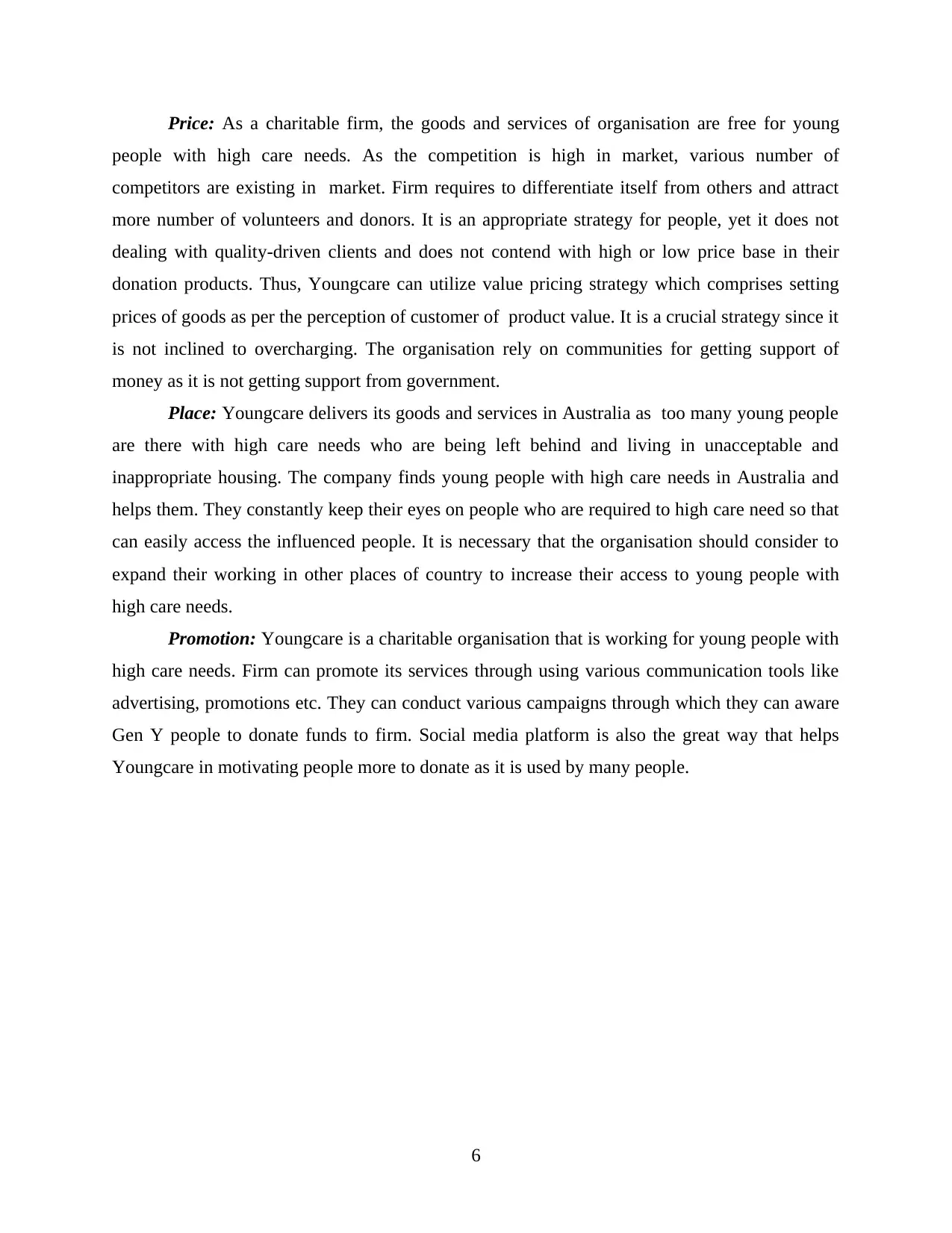
Price: As a charitable firm, the goods and services of organisation are free for young
people with high care needs. As the competition is high in market, various number of
competitors are existing in market. Firm requires to differentiate itself from others and attract
more number of volunteers and donors. It is an appropriate strategy for people, yet it does not
dealing with quality-driven clients and does not contend with high or low price base in their
donation products. Thus, Youngcare can utilize value pricing strategy which comprises setting
prices of goods as per the perception of customer of product value. It is a crucial strategy since it
is not inclined to overcharging. The organisation rely on communities for getting support of
money as it is not getting support from government.
Place: Youngcare delivers its goods and services in Australia as too many young people
are there with high care needs who are being left behind and living in unacceptable and
inappropriate housing. The company finds young people with high care needs in Australia and
helps them. They constantly keep their eyes on people who are required to high care need so that
can easily access the influenced people. It is necessary that the organisation should consider to
expand their working in other places of country to increase their access to young people with
high care needs.
Promotion: Youngcare is a charitable organisation that is working for young people with
high care needs. Firm can promote its services through using various communication tools like
advertising, promotions etc. They can conduct various campaigns through which they can aware
Gen Y people to donate funds to firm. Social media platform is also the great way that helps
Youngcare in motivating people more to donate as it is used by many people.
6
people with high care needs. As the competition is high in market, various number of
competitors are existing in market. Firm requires to differentiate itself from others and attract
more number of volunteers and donors. It is an appropriate strategy for people, yet it does not
dealing with quality-driven clients and does not contend with high or low price base in their
donation products. Thus, Youngcare can utilize value pricing strategy which comprises setting
prices of goods as per the perception of customer of product value. It is a crucial strategy since it
is not inclined to overcharging. The organisation rely on communities for getting support of
money as it is not getting support from government.
Place: Youngcare delivers its goods and services in Australia as too many young people
are there with high care needs who are being left behind and living in unacceptable and
inappropriate housing. The company finds young people with high care needs in Australia and
helps them. They constantly keep their eyes on people who are required to high care need so that
can easily access the influenced people. It is necessary that the organisation should consider to
expand their working in other places of country to increase their access to young people with
high care needs.
Promotion: Youngcare is a charitable organisation that is working for young people with
high care needs. Firm can promote its services through using various communication tools like
advertising, promotions etc. They can conduct various campaigns through which they can aware
Gen Y people to donate funds to firm. Social media platform is also the great way that helps
Youngcare in motivating people more to donate as it is used by many people.
6
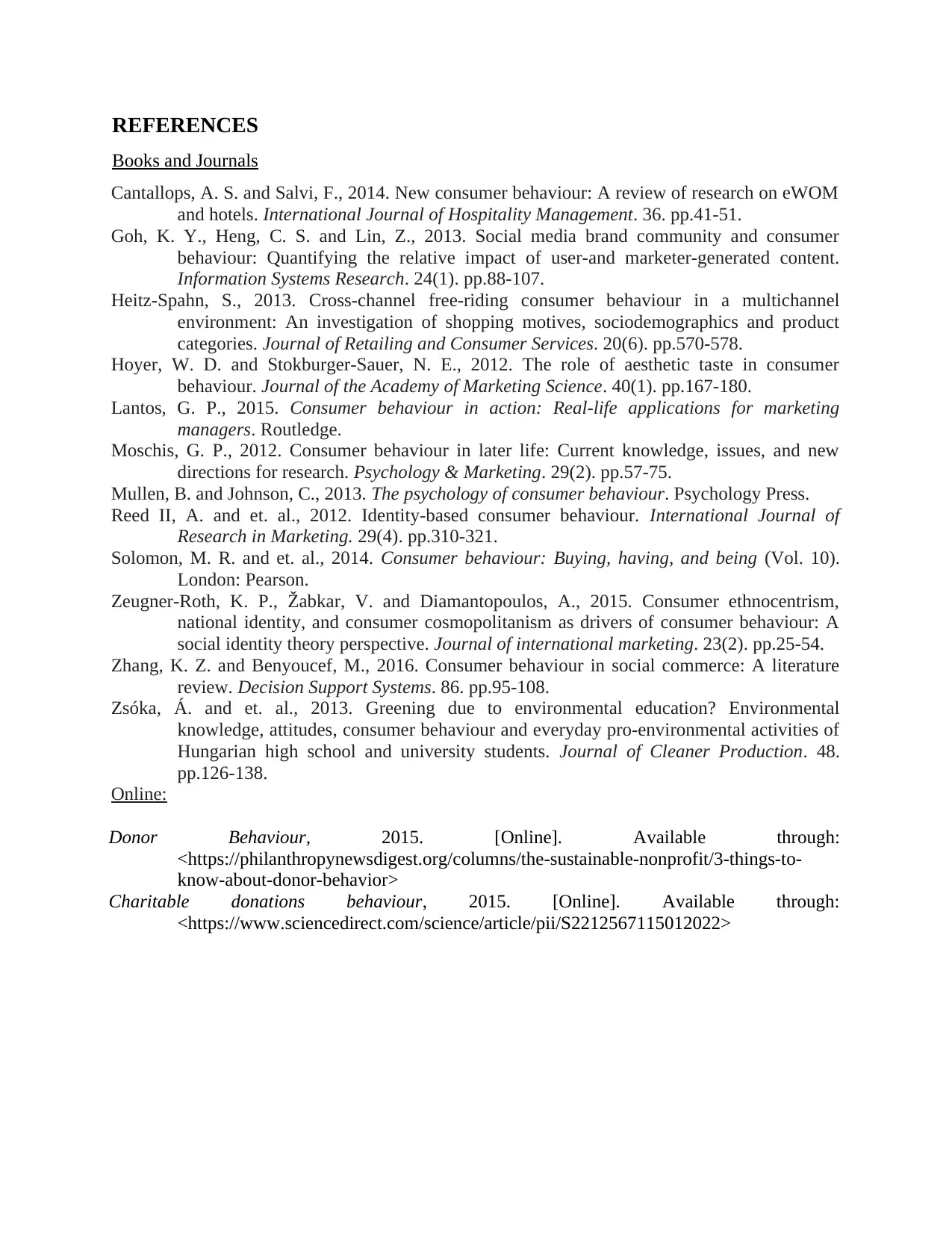
REFERENCES
Books and Journals
Cantallops, A. S. and Salvi, F., 2014. New consumer behaviour: A review of research on eWOM
and hotels. International Journal of Hospitality Management. 36. pp.41-51.
Goh, K. Y., Heng, C. S. and Lin, Z., 2013. Social media brand community and consumer
behaviour: Quantifying the relative impact of user-and marketer-generated content.
Information Systems Research. 24(1). pp.88-107.
Heitz-Spahn, S., 2013. Cross-channel free-riding consumer behaviour in a multichannel
environment: An investigation of shopping motives, sociodemographics and product
categories. Journal of Retailing and Consumer Services. 20(6). pp.570-578.
Hoyer, W. D. and Stokburger-Sauer, N. E., 2012. The role of aesthetic taste in consumer
behaviour. Journal of the Academy of Marketing Science. 40(1). pp.167-180.
Lantos, G. P., 2015. Consumer behaviour in action: Real-life applications for marketing
managers. Routledge.
Moschis, G. P., 2012. Consumer behaviour in later life: Current knowledge, issues, and new
directions for research. Psychology & Marketing. 29(2). pp.57-75.
Mullen, B. and Johnson, C., 2013. The psychology of consumer behaviour. Psychology Press.
Reed II, A. and et. al., 2012. Identity-based consumer behaviour. International Journal of
Research in Marketing. 29(4). pp.310-321.
Solomon, M. R. and et. al., 2014. Consumer behaviour: Buying, having, and being (Vol. 10).
London: Pearson.
Zeugner-Roth, K. P., Žabkar, V. and Diamantopoulos, A., 2015. Consumer ethnocentrism,
national identity, and consumer cosmopolitanism as drivers of consumer behaviour: A
social identity theory perspective. Journal of international marketing. 23(2). pp.25-54.
Zhang, K. Z. and Benyoucef, M., 2016. Consumer behaviour in social commerce: A literature
review. Decision Support Systems. 86. pp.95-108.
Zsóka, Á. and et. al., 2013. Greening due to environmental education? Environmental
knowledge, attitudes, consumer behaviour and everyday pro-environmental activities of
Hungarian high school and university students. Journal of Cleaner Production. 48.
pp.126-138.
Online:
Donor Behaviour, 2015. [Online]. Available through:
<https://philanthropynewsdigest.org/columns/the-sustainable-nonprofit/3-things-to-
know-about-donor-behavior>
Charitable donations behaviour, 2015. [Online]. Available through:
<https://www.sciencedirect.com/science/article/pii/S2212567115012022>
Books and Journals
Cantallops, A. S. and Salvi, F., 2014. New consumer behaviour: A review of research on eWOM
and hotels. International Journal of Hospitality Management. 36. pp.41-51.
Goh, K. Y., Heng, C. S. and Lin, Z., 2013. Social media brand community and consumer
behaviour: Quantifying the relative impact of user-and marketer-generated content.
Information Systems Research. 24(1). pp.88-107.
Heitz-Spahn, S., 2013. Cross-channel free-riding consumer behaviour in a multichannel
environment: An investigation of shopping motives, sociodemographics and product
categories. Journal of Retailing and Consumer Services. 20(6). pp.570-578.
Hoyer, W. D. and Stokburger-Sauer, N. E., 2012. The role of aesthetic taste in consumer
behaviour. Journal of the Academy of Marketing Science. 40(1). pp.167-180.
Lantos, G. P., 2015. Consumer behaviour in action: Real-life applications for marketing
managers. Routledge.
Moschis, G. P., 2012. Consumer behaviour in later life: Current knowledge, issues, and new
directions for research. Psychology & Marketing. 29(2). pp.57-75.
Mullen, B. and Johnson, C., 2013. The psychology of consumer behaviour. Psychology Press.
Reed II, A. and et. al., 2012. Identity-based consumer behaviour. International Journal of
Research in Marketing. 29(4). pp.310-321.
Solomon, M. R. and et. al., 2014. Consumer behaviour: Buying, having, and being (Vol. 10).
London: Pearson.
Zeugner-Roth, K. P., Žabkar, V. and Diamantopoulos, A., 2015. Consumer ethnocentrism,
national identity, and consumer cosmopolitanism as drivers of consumer behaviour: A
social identity theory perspective. Journal of international marketing. 23(2). pp.25-54.
Zhang, K. Z. and Benyoucef, M., 2016. Consumer behaviour in social commerce: A literature
review. Decision Support Systems. 86. pp.95-108.
Zsóka, Á. and et. al., 2013. Greening due to environmental education? Environmental
knowledge, attitudes, consumer behaviour and everyday pro-environmental activities of
Hungarian high school and university students. Journal of Cleaner Production. 48.
pp.126-138.
Online:
Donor Behaviour, 2015. [Online]. Available through:
<https://philanthropynewsdigest.org/columns/the-sustainable-nonprofit/3-things-to-
know-about-donor-behavior>
Charitable donations behaviour, 2015. [Online]. Available through:
<https://www.sciencedirect.com/science/article/pii/S2212567115012022>
⊘ This is a preview!⊘
Do you want full access?
Subscribe today to unlock all pages.

Trusted by 1+ million students worldwide
1 out of 9
Related Documents
Your All-in-One AI-Powered Toolkit for Academic Success.
+13062052269
info@desklib.com
Available 24*7 on WhatsApp / Email
![[object Object]](/_next/static/media/star-bottom.7253800d.svg)
Unlock your academic potential
Copyright © 2020–2025 A2Z Services. All Rights Reserved. Developed and managed by ZUCOL.





